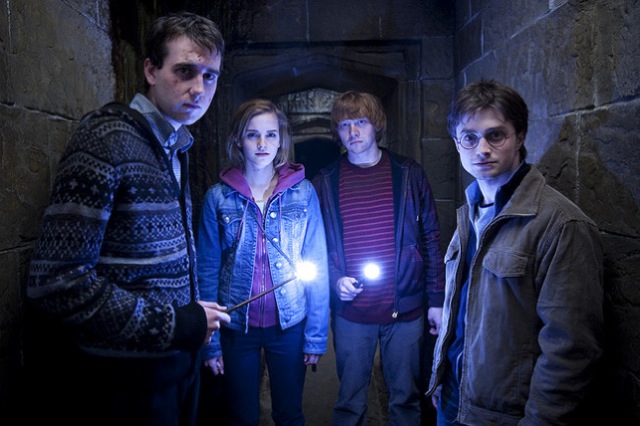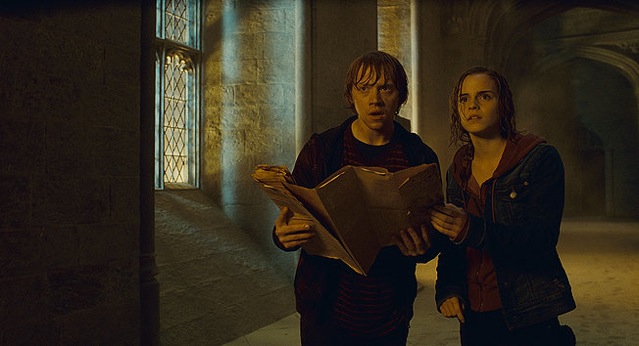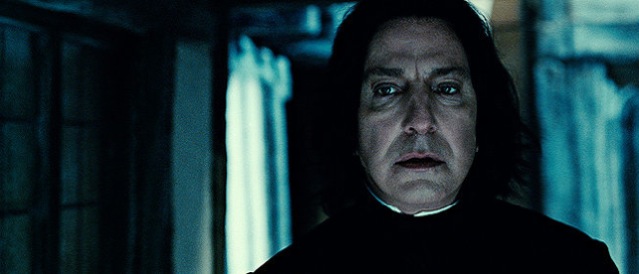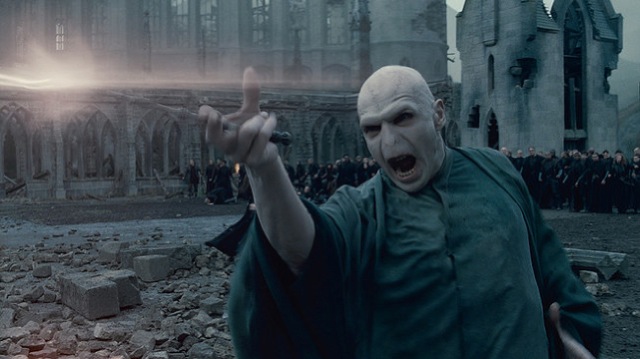CHICAGO – Patrick McDonald of HollywoodChicago.com appears on “The Morning Mess” with Dan Baker on WBGR-FM (Monroe, Wisconsin) on March 21st, 2024, reviewing the new streaming series “Manhunt” – based on the bestseller by James L. Swanson – currently streaming on Apple TV+.
Film Feature: 10 Most Controversial Moments in ‘Harry Potter and the Deathly Hallows’
CHICAGO – Taken as one complete film, “Harry Potter and the Deathly Hallows” is easily the best installment of the series. By splitting J.K. Rowling’s spellbinding final book into two parts, director David Yates and screenwriter Steve Kloves had much more time to pace each sequence and develop each character to the best of their ability. The added minutes have enabled them to deliver a rousing finale to one of the greatest franchises in history.
That being said, I freely admit that my experience of growing up with Harry Potter has contributed considerably to my impassioned involvement in the subsequent film adaptations. To say the books are better than the movies would be to miss the point entirely. Literature and cinema are entirely different languages and must be judged on their own terms. The extraordinary thing about the “Potter” films is the fact that they have continued to get better and better with each passing year. Yet even in the sublime “Deathly Hallows,” there are a handful of moments that have caused otherwise entranced moviegoers to raise their eyebrows.
Instead of dismiss these reservations as mere quibbles, I’ve decided to deconstruct each of them in order to determine whether they indeed hold the film back from greatness. After gauging audience responses at three separate screenings of “Part 2,” I have come up with ten moments that I would deem the most controversial in the entirety of “Deathly Hallows.” A word of caution: this article is intended solely for moviegoers who have seen the final film, and judging by the film’s record-breaking opening week at the box office, there are a great many of you out there. Nearly every single one of these moments could be deemed a spoiler, so for the Muggles who haven’t seen “Part 2,” please do as soon as possible (it’s the hottest ticket this season, by far). For everyone who already cheered (and jeered) at the epic showdown between Harry Potter and Voldemort, I encourage you to join in the debate regarding these wisely disputed scenes. Here they are, in order of appearance…

Matthew Lewis, Emma Watson, Rupert Grint and Daniel Radcliffe star in Harry Potter and the Deathly Hallows: Part 2.
Photo credit: Warner Bros. Pictures
1.) The Dance
One of the greatest shortcomings of any adaptation is the need to condense. The weakest page-to-screen transfers play like visual SparkNotes montages, comprised entirely of exposition enabling each scene to lead swiftly to the next (for a particularly soulless example, check out the “Da Vinci Code” films). It’s rare when an adaptation can take a moment to breathe and allow its characters to simply behave. That’s precisely what Yates and Kloves manage to do during the tensest section of “Deathly Hallows: Part 1,” as the young heroes find themselves lost in the woods, unsure about what to do next. Ron has left in a huff, leaving Harry and Hermione to hunt the Horcruxes on their own. Their “dance” takes place during a scene entirely invented by the filmmakers, as the two longtime friends allow themselves to momentarily become kids again.
Sure, the last thing fans were expecting was the jarringly contemporary voices of Nick Cave & The Bad Seeds popping up in a “Potter” flick, but their haunting rendition of “O Children” sounds gloriously poignant as it emanates from Hermione’s radio. It’s the first time in quite a while that the luminous Emma Watson is allowed to smile, and her refreshing looseness instantly evokes memories of her exuberant early years in the franchise, before she became weary of playing a witch for the remainder of her adolescence. Some fans have speculated about the scene’s hinting of an attraction between the two characters, but I found their shared warmth entirely platonic. This scene is the sort of gem that’s often guaranteed a place on the cutting room floor, if only because it commits the sin of not moving along the plot. If Yates had left it out, he would’ve been cutting the film’s heart. It may be my favorite moment in all of “Deathly Hallows.”
2.) The Nude Scene
For all those who thought the previous scene indicated possible chemistry between Daniel Radcliffe and Emma Watson, this moment may have satisfied their curiosity all too well. Though neither star technically appears “nude,” it’s clear that they aren’t wearing anything apart from some strategically placed clouds of smoke. No matter how integral the filmmakers thought this image was to their portrayal of Ron’s tormented psyche, it didn’t do much more than inspire incredulous howls at midnight screenings around the globe. It’s a pity, especially considering how the surrounding sequence is a well-realized staging of the Satan-like spell Voldemort casts upon Ron as he attempts to destroy one of the Horcruxes. Ron’s mistaken suspicion of his friends’ lustful attraction toward one another is exploited by Voldemort, who conjures silver-skinned apparitions of Harry and Hermione. They taunt Ron before instantly doffing their clothes and making out. Since romantic subplots have always been the weakest aspects of a “Potter” picture, this last-second stab at eroticism is jarring beyond belief. It also evokes unwelcome memories of Radcliffe’s nude work in “Equus” and Watson’s professed desire to shed her clothes for Bernardo Bertolucci. It’s as if some perverted fan fiction writer secretly inserted a page into the script for “Deathly Hallows,” and it somehow ended up on film.

Rupert Grint and Emma Watson star in Harry Potter and the Deathly Hallows: Part 2.
Photo credit: Warner Bros. Pictures
3.) The Ron/Hermione Kiss
One of Yates’s greatest triumphs was his ability to actually make the budding love story between Ron and Hermione wholly credible. Even when I read the books, I wasn’t entirely sold on the attraction Rowling attempted to contrive between the two characters, whose bickering sounded less like that of a married couple than playful siblings. It’s primarily through silent expressions in “Part 1,” mainly conveyed by the marvelously nuanced face of Rupert Grint, that Yates was able to establish a connection that felt like something more than friendship. The build-up crystalizes beautifully in “Part 2,” as the two characters consummate their feelings for one another with an exquisitely timed kiss. Instead of previous “Potter” lip-smacks that take place after an ungainly series of lines designed to mask the young actors’ woeful lack of chemistry, Kloves doesn’t bother preceding the much-hyped moment with dialogue. Instead, he allows the kiss to occur immediately after Ron and Hermione have risked their lives while performing their latest act of improvisational heroism. Their passion for one another grows organically out of their shared exhilaration. It’s an impeccable expression of the simple reason why they’re attracted to one another: they’ve been through so much together. Plus, their subsequent giggle rids the moment of any nagging awkwardness.
4.) The Harry/Ginny Kiss
Sadly, the same cannot be said for Harry and Ginny’s less-hyped, predictably unsatisfactory snog. It’s the final nail in the coffin for this failed subplot—so sweet within the pages of Rowling’s text, so painfully wrongheaded whenever it rears its blurry-eyed head onscreen. The biggest problem is Ginny herself, played by the fatally wooden Bonnie Wright. She’s been nothing more than a one-dimensional damsel ever since she was saved by Harry in “Chamber in Secrets.” Her acting in that film was entirely nonexistent. She delivered her lines as she were reading them for the first time. In recent years, Wright has attempted to sound more naturalistic by utilizing a more mumbly, clipped speech that ultimately doesn’t sound any less hollow than her earlier zombie-like recitations.
Kloves doesn’t help matters with his refusal to develop their attraction beyond Harry’s vague admittance to Ron (in “Half-Blood Prince”) that he likes Ginny’s skin. I always thought Harry and Luna would’ve made a better match, considering how both of them have the ability to envision things that others can’t. Plus Evanna Lynch’s loopy portrayal of Luna is infinitely more beguiling than Wright’s immobile presence. As chaos engulfs her classmates in “Part 2,” Ginny still manages to remain frozen. Even with Neville hanging off a crumbling bridge, she just stands there like an unpossessed chess piece. So it’s really no surprise when Harry and Ginny face each other for what may be the last time in their potentially short lives, and Ginny does nothing more than plant a stilted peck on the lips of the man she allegedly loves.

Alan Rickman stars in Harry Potter and the Deathly Hallows: Part 2.
Photo credit: Warner Bros. Pictures
5.) The Flashback
Now with the weakest character out of the way, let’s concentrate on the strongest. From the instant he literally burst onto the screen in “Sorcerer’s Stone,” Severus Snape has always been the most fascinatingly complex and compulsively entertaining character in the “Potter” saga. With his syllable-contorting line delivery and hypnotically reptilian body language, Alan Rickman created an iconically sinister figure of bottomless intrigue. Yet it wasn’t until “Part 2” that Snape’s repressed emotions were finally able to break free in an extended flashback montage (via a Pensieve) that is truly the most riveting moment in the entire picture. Composer Alexandre Desplat’s masterful use of past scores is particularly moving here, as the melancholy tones of “Dumbledore’s Farewell” (written by Nicholas Hooper for “Half-Blood Prince”) are heard during the late professor’s tragic backstory, culminating in his tearful embrace of Lily, Harry’s dead mother, whom Snape had always secretly loved.
This head-spinning twist was galvanizing in Rowling’s book, and editor Mark Day skillfully paces the sequence, enabling the audience to feel as if they are gradually connecting the dots along with Harry. Though Rickman’s screen time in “Part 2” is brief, allowing the actor no more than a single deliciously prolonged line reading (“they will be treated as…e—qual—ly guilty”), his work during the flashback sequence is thoroughly heartbreaking and deeply moving. As far as I’m concerned, it makes Rickman’s capper to a brilliant eight-picture performance worthy of an Oscar nod. The only real controversy provoked by this sequence is its muddled meaning for viewers unfamiliar with the story (some feel that it makes Snape look like Harry’s father). It’s also worth noting that the entire Lily/Snape subplot is remarkably similar to the Lily/Craven subplot in Marsha Norman and Lucy Simon’s 1991 musical adaptation of Frances Hodgson Burnett’s novel “The Secret Garden.” Both stories feature a “villain” haunted by the eyes of a young protagonist with a dead mother named Lily (in both cases, the villain loved Lily, but she ended up falling for his rival). Is this subplot a clever homage or blatant plagiarism?
6.) The Dream Sequence
Strangeness accompanied by an eerie quiet are always reliable ingredients for uncomfortable snickers, and that is precisely what this sequence has generated. It takes place immediately after Voldemort has supposedly killed Harry, and includes an ambiguous conversation between the deceased boy wizard and his trusted mentor, Dumbledore (Michael Gambon). Ever since Gambon replaced the late Richard Harris in “Prisoner of Azkaban,” several fans have blasted Gambon for his aggressive portrayal of a gentle character, and his refusal to read Rowling’s original text. I may be in the minority, but I find Gambon’s portrayal absolutely essential to the evolution of his character from a larger-than-life god to a flawed and distressingly fallible human being. Gambon also isn’t above injecting some wry humor into the role, and his deadpan delivery is a welcome addition to Harry’s imagined encounter in “Part 2.” What viewers unfamiliar with the books will find wholly incomprehensible about the sequence is the shocking appearance of what looks like a bloodied Voldemort fetus. It’s meant to represent the part of Voldemort’s soul that was killed in the preceding wand blast, thus relieving Harry of his identity as a Horcrux. Kloves doesn’t bother to explain this, and his preference for ambiguity is admirable, though it’s bound to inspire much head-scratching.
7.) The Rise of Neville Longbottom
So…is Neville Longbottom the Chosen One? I think not. He is merely the character who has undergone the greatest transformation during his seven years at Hogwarts. His vital heroism in “Part 2” is very much in keeping with the preceding dream sequence, where Dumbeldore tells Harry that help will always come to those at Hogwarts who need it. The Sword of Gryffindor was bound to appear to a student—it just happened to be Neville. And it seriously couldn’t have happened to a nicer guy. Audiences have riotously cheered Neville on during the final act, and it’s easy to see why they love him. It’s not just his bravery, pluck and dashing good looks, it’s also because…well, he’s still the same lovable, neurotic, cardigan-wearing character that he always was. Matthew Lewis pulls off the difficult task of taking his character to the next level while still keeping his tender spirit and relatable vulnerability intact. Lewis has always been one of the finest young actors in the series, and his star turn here is entirely earned.

Ralph Fiennes stars in Harry Potter and the Deathly Hallows: Part 2.
Photo credit: Warner Bros. Pictures
8.) The Fall of Voldemort
After seven pictures of ominous foreboding, Voldemort is finally revealed to be a character based entirely in hype. All one has to do is dare to say his name, and already he’s lost some of his power. Though the final battle in “Part 2” is true to the novel in its anti-climactic nature, it may prove to disappoint viewers expecting an explosive death of the evil demon. Instead, Voldemort merely disintegrates into the air as Harry drifts into obscurity. There’s something beautiful about the way peace and order are restored to the world with a nearly wordless calm. Perhaps what’s more troubling is Ralph Fiennes’s portrayal of Voldemort as he begins to lose his grip on power. Fiennes’s performance has been electrifying throughout the series, but here his non-threatening cackle takes on an almost comical nature. When Voldemort declares that Harry Potter is dead, the subsequent wicked (yet passionless) guffaws of his followers inspire a laugh at the worst possible moment. Fiennes gives it his all, and he’s still fascinating to watch, but the lack of palpable terror is a bit of a letdown.
9.) The Line Everyone Has Waited For
As soon as fans finished “Deathly Hallows,” the line everyone’s been waiting to see on film is Mrs. Weasley’s enraged exclamation, “Not my daughter, you BITCH!” before offing the loathsome Bellatrix Lestrange. It was a moment destined to become a surefire crowd-pleaser, and the film didn’t disappoint. Though Julie Walters resists delivering the words with the conviction some may have hoped, she was wise in not attempting to top the infamous movie line that so obviously inspired it: Sigourney Weaver’s badass snarl, “Get away from her, you BITCH!” in James Cameron’s “Aliens.” The moment is intensely satisfying, spectacularly visualized and over far too quickly. It is also the moment that has inspired the largest applause at every screening I’ve attended.
10.) The Epilogue
Alas, the most problematic scene in “Part 2” is saved for the very end. It’s an epilogue set 19 years in the future that commits the critical error of featuring the same young actors decked out in unconvincing, digitally enhanced makeup. It plays like the type of deleted scene one watches on DVD while breathing a sigh of relief that the filmmakers weren’t dense enough to include it in the final cut. It’s a damned shame, considering how poignant the scene is, both in terms of its premise and execution (Desplat’s use of John Williams’s “Leaving Hogwarts” theme is an utter masterstroke).
If Yates had shown me a rough cut of “Part 2,” here’s how I would advise him to change the epilogue. First of all, get rid of Radcliffe, Grint and Watson. The preceding shot of them standing together on the bridge near Hogwarts is the perfect final image of these beloved actors. Audiences have loved watching them literally age before their eyes. Don’t botch the magic of their organic aging process with an outrageously unbelievable act of dress-up right in the final inning. The remarkable casting directors that selected the adult actors in “Part 1” (whom the three stars posed as via Polyjuice Potion in the Ministry of Magic) could certainly find suitable choices for adult versions of Harry, Ron and Hermione. Also, get rid of the inexplicable touchy-feely shot of a fatherly Draco Malfoy—there’s no reason why audiences should have any warm feelings toward him. Okay, so Harry and his son have their chat and then the boy hops aboard the Hogwarts Express. Williams’s music begins to swell as Harry waves to his son. This is where Day could’ve inserted an archival shot of Radcliffe (at the end of “Sorcerer’s Stone”) waving back to Harry. This would allow Harry to literally see himself in his son, creating a moment of misty-eyed poignance. The adult actor would also be able to project a middle-aged wistfulness that the 21-year-old Radcliffe simply couldn’t pull off. This would’ve earned the film rapturous cheers and applause without a single smattering of derisive laughter.
 | By MATT FAGERHOLM |



On the Ten Moments
1. One of the things that could not be predicted was the fact that Radcliffe and Watson have better chemistry than Grint and Watson. This scene played on it, but it wasn’t entirely platonic. In the last moments you can see both Harry and Hermione realizing that they could cross a line here, but it just couldn’t work for them. The scene is completely without dialogue and is one of the best acted moments in the series.
2. The shock of the nude scene added emotional weight to Ron’s temptation and inner conflict. Yeah, it’s a bit unexpected, but spot on.
3. I don’t know why you blame Rowling for this. In the books the Ron/Hermione relationship is much more believable, but it suffers in the movie series because of the non-chemistry between Grint and Watson and because most of their romance is cut out of the series.
4. Again, this is a chemistry issue between the actors, although Ginny comes into her own onscreen in Half-Blood Prince. The romance is cut short in both the final book and the movie. Personally, I wish Rowling had created a female Slytherin character to be Harry’s love interest. That way not all of Slytherin would be thugs, and besides, bad girls go better with nice guys.
5. Don’t even know where the controversy is in here. Rickman FTW.
6. Yeah, whatever. It’s in the book, Harry’s in the scene, so it has to be in the movie.
7. Neville Longbottom is the New Chuck Norris. Because when Chuck Norris sees a boggart, it turns into Neville Longbottom. Plus, the biggest rewrite in the movie was Neville and Luna, a match that didn’t happen in the books but thankfully is given a nod here.
8. Nobody laughed when the Death Eaters chuckled at Potter’s supposed demise at any of the screenings I went to. It was a wonderfully tense scene even though just about everyone knew the outcome.
9. That duel was pretty cool, but I thought it was filmed a bit too tightly. It felt kind of static for a fight sequence.
10. Actually, having minimal dialogue and focusing the scene on Albus made the epilogue touching enough without some cheesy doubling or archival shot of Radcliffe. I hated the epilogue in the book, but in the movie it delivers the message that life goes on, people change and the adventure begins with the next generation. Adding a “young Harry” shot would have ruined that.
Bonnie can only do so much
Bonnie can only do so much when they give her crap. Seriously, she gets absolutely nothing to work with. The very few times she’s given a chance to do something other than stand there and moon at Harry, I actually thought she was good. Like when she sees Harry’s dead body? I actually teared up at her reaction. But the fact is, the writer/director just butchered her character. I have always felt Ron was the most butchered character, but I’ve started to think Ginny has it worse. She gets absolutely none of her scenes from the books. Ron is a close second though. The writers/directors seem so intent on making a Harry/Hermione coupling (they insisted the dance scene was meant to have sexual tension, something that was never hinted at in the books) that Ron and Ginny get ruined in the process. I liked both Harry/Ginny and Ron/Hermione in the books, but I don’t really care about either on film. Such a pity.